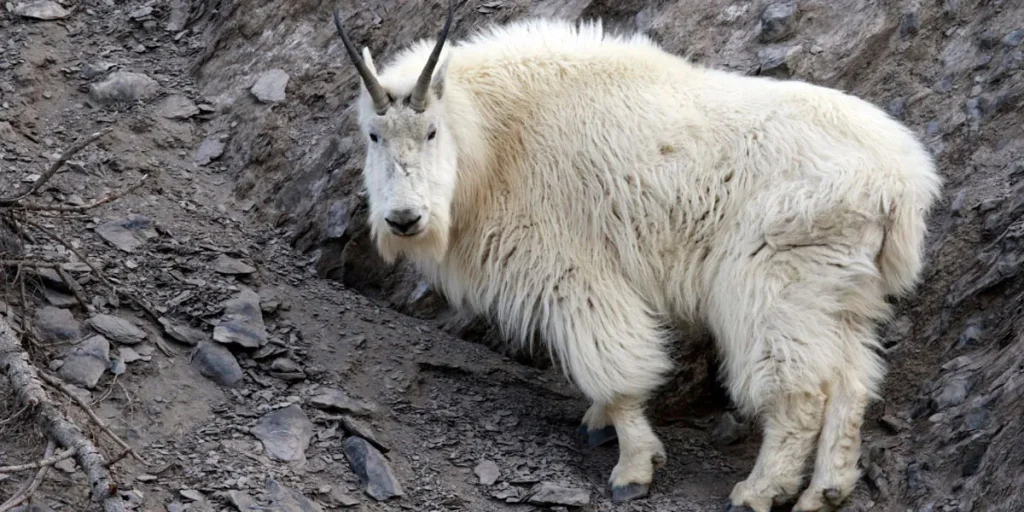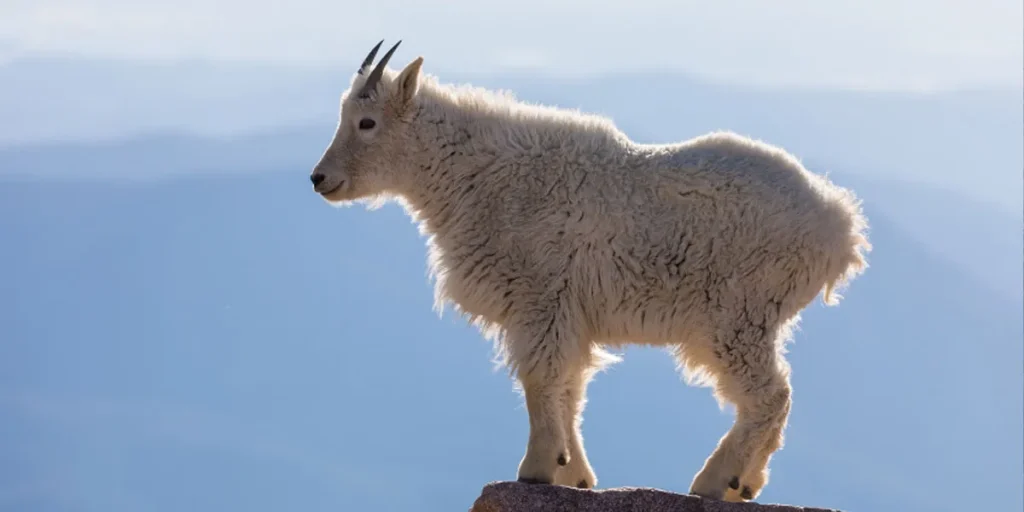A mature mountain goat typically weighs between 100 to 300 pounds (45 to 136 kg). The average weight is around 180 pounds (82 kg).
Mountain goats, known for their climbing agility, are fascinating creatures that embody strength and survival in their harsh, mountainous habitats.
Their weight contributes significantly to their balance and stability on the steep, rocky slopes they navigate daily.
Understanding the mass of these animals helps to appreciate the balance they maintain between power and agility.
Despite their substantial weight, mountain goats exhibit exceptional climbing skills, a testament to their muscle density and body structure.
Their weight also varies depending on gender, with males (billies) being heavier than females (nannies), especially during the breeding season.
The size and weight of these animals matter greatly, not just for their own survival, but for wildlife enthusiasts and biologists who study the health and dynamics of these alpine populations.
Mountain Goat Mystique
Mountain goats, Oreamnos americanus, stand as a symbol of the rugged beauty and the sheer force of will found within nature.
These agile climbers, shrouded in their dense white coats, capture the essence of the high-altitude world they dominate.
They traverse steep and rocky terrains with a finesse that belies their size, embodying an enigma that both mystifies and intrigues.
Majestic Inhabitants Of High Altitude Terrain
Found in the remote reaches of the North American mountains, mountain goats master their high-altitude homes.
Average adults weigh between 100 to 300 pounds, with males, called billies, typically heavier than females, known as nannies.
Their presence is like a touch of wilderness whimsy atop the rugged peaks.
Adaptations For An Alpine Lifestyle
Mountain goats have evolved to survive where few dare to dwell. Their thick, woolly coats provide insulation against the harsh alpine climate.
Their hooves are a marvel, designed with a hard outer edge and a soft, gripping center to cling to the sheer rock face.
Their well-built bodies offer both power and agility, crucial for their vertical world. This table summarizes key adaptations:
| Feature | Adaptation | Benefit |
|---|---|---|
| Coat | Thick, woolly | Insulation |
| Hooves | Hard edge, soft center | Grip and balance |
| Body | Sturdy, muscular | Agility and power |
Young mountain goats, or kids, quickly learn to navigate their vertical world. They follow their mothers and mimic their movements, gaining strength and confidence with each step.
Their lifelong honing of these skills speaks to the marvel of the mountain goat’s existence.
Diving Into The Data: Average Weights Explored

Mountain goats are fascinating creatures. They roam high above the treeline on steep, rocky faces.
Their weight is a key factor in their survival. Let’s explore what the average mountain goat weighs and understand why these weights can vary so much.
Variability In Male And Female Mountain Goats
Male and female mountain goats don’t tip the scales the same way. Known as sexual dimorphism, this difference is quite common in the animal kingdom.
Males are typically heavier than females. This can impact their dominance and mating success.
| Gender | Average Weight |
|---|---|
| Males (Billies) | 120 to 300 pounds |
| Females (Nannies) | 100 to 210 pounds |
Influence Of Habitat On Body Mass
The habitat of a mountain goat dictates its diet and lifestyle. This can influence its body mass.
Goats living in lush areas with plenty of food might be heavier. Those in rugged, sparse environments could be lighter.
- Lush habitats: better food, possibly heavier goats
- Sparse areas: less food, possibly lighter goats
The Impact Of Seasonal Changes
Mountain goats awe us with more than just their climbing skills. Their weight also tells a survival story shaped by the seasons.
Unlike a static number on a scale, the weight of a mountain goat fluctuates throughout the year, adapting to the harsh mountain environment.
These changes are essential for their survival. Let’s explore how seasonal patterns affect a mountain goat’s weight.
Bulking Up For Winter: Seasonal Weight Gain
As winter approaches, mountain goats face colder temperatures and scarcer food supplies. Instinct drives them to eat more in the fall to prepare for the tough months ahead.
- Increased Caloric Intake: Goats consume more calories to build fat reserves.
- Dense Coat Growth: They grow thicker fur, adding to their apparent size and weight.
- Energy Conservation: Reduced movement to preserve energy results in weight gain.
| Season | Average Weight Gain |
|---|---|
| Autumn (Pre-Winter) | 10-20% of body weight |
By December, a healthy adult mountain goat might weigh 30 pounds more than in the summer.
The Shedding Cycle: Losing Weight Before Summer
When snow melts, mountain goats begin a shedding cycle. They lose weight to stay agile and cool during the warmer months.
- Fat Reserves Depletion: Goats use up stored fat as food becomes abundant again.
- Winter Coat Shedding: Lighter summer coats replace thick winter fur.
- Increased Activity: More movement and foraging lead to a leaner physique.
As summer peaks, an adult goat can weigh up to 20% less than during winter. This weight loss is critical for their agility and reproductive success in the rugged terrain.
From Kids To Billies And Nannies

Witnessing the majestic mountain goat’s journey from playful kids to full-grown billies and nannies is an awe-inspiring experience.
This magnificent creature’s weight plays a critical role in its survival and development. Let’s take a closer look at the fascinating growth stages of mountain goats and discover how their weights change throughout their lives.
Tracking Mountain Goat Development
From the moment they are born, mountain goat kids initiate a rapid growth phase. A newborn kid typically weighs 2.5 to 3.5 kg (5.5 to 7.7 lbs), a small bundle of agility and energy.
Over the following weeks and months, these kids experience significant growth spurts.
- First Month: Doubles their birth weight
- Up to Six Months: Weigh between 12 to 15 kg (26 to 33 lbs)
During the first year, the youngsters remain reliant on their mothers but also start sampling vegetation.
This is a vital period as they refine their survival skills and continue growing at a remarkable pace.
When Is A Mountain Goat At Its Heaviest?
Mountain goats reach their prime weight during adulthood. This period typically starts when they are around four to five years old.
Males, known as billies, become more massive than females or nannies.
| Gender | Weight Range |
|---|---|
| Billies | 100 to 140 kg (220 to 309 lbs) |
| Nannies | 55 to 70 kg (121 to 154 lbs) |
At this stage, billies showcase their strength, particularly during the rutting season when they vie for mates.
Nannies also reach a considerable weight, essential for nurturing their young. Maintaining a healthy weight is key to the survival of these alpine residents.
Why Weight Matters To Mountain Goats?
The alpine world is a challenging one, where every ounce matters. For mountain goats, their weight is a critical factor in their survival.
Survival Of The Fittest: Weight And Health
Mountain goats face steep, rugged terrains daily. A healthy weight is key to their agility and endurance.
It’s a balance – too heavy and climbing becomes taxing; too light and they lack reserves for harsh conditions.
Researchers have found that goats with optimal weight have better health and longevity.
- Optimal weight helps in efficient food utilization
- Heavier weights can cause strain on their joints
- Lighter weights may indicate health issues or poor nutrition
Reproductive Success And Weight Correlations
The ability to reproduce is critical for mountain goats. Studies show a strong link between weight and breeding success.
Female goats at healthier weights have a higher chance of successfully bearing offspring. The right weight impacts many aspects:
- Attractiveness to potential mates
- Ability to carry a pregnancy to term
- Health and growth of offspring
| Average Weight Range | Health Impact | Reproductive Impact |
|---|---|---|
| Light | Potential Nutrition Issues | Lower Chances of Mating |
| Optimal | Peak Agility and Endurance | Higher Fertility Rates |
| Heavy | Joint Stress, Less Mobility | Possibly Lowered Fertility |
Conservation Efforts To Protect The Gargantuan Grazers
Mountain goats, known for their impressive climbing ability, stand as a symbol of rugged mountain ecosystems.
Adult mountain goats usually weigh between 100 and 300 pounds, varying by gender and habitat.
Yet, beyond their physical prowess, these majestic animals face challenges imposed by human activity. Conservation efforts remain essential to safeguard their future.
Human Impacts On Mountain Goat Populations
Human encroachment plays a significant role in altering the habitats of these magnificent creatures. Below are key points highlighting human-induced challenges:
- Habitat loss due to development and resource extraction
- Climate change affecting their alpine environment
- Recreational activities leading to disturbance and stress
- Poaching and illegal hunting threats
Future Prospects: Ensuring The Giants Continue To Roam
Protecting mountain goats requires a proactive approach:
- Create and enforce wildlife sanctuaries
- Implement regulations on hunting
- Reduce human-wildlife conflict zones
- Promote research into habitat preservation
- Involve local communities in conservation initiatives
Through these steps, the prospects of sustaining healthy mountain goat populations improve.
Collaboration between governments, conservation groups, and the public is key. With continued efforts, these gargantuan grazers will thrive, gracing the mountainsides for generations to come.
FAQ About the Weight of a Mountain Goat
What Is The Average Weight Of A Mountain Goat?
Adult mountain goats typically weigh between 100 and 300 pounds (45 to 136 kilograms).
Females, called nannies, generally weigh less than males, known as billies.
Can Mountain Goat Weight Vary By Age?
Yes, the weight of a mountain goat can vary significantly with age.
Juvenile goats weigh less, with kids born at around 6 pounds (2. 7 kilograms) and growing steadily thereafter.
How Much Do Male Mountain Goats Weigh?
Male mountain goats, or billies, are heavier than females, weighing between 180 and 300 pounds (82 to 136 kilograms) on average.
Their weight can peak during mating season.
Do Mountain Goats’ Weights Differ By Season?
Mountain goats’ weights can fluctuate seasonally; they typically gain weight in the summer when food is abundant and lose weight during the harsh winter months.
Conclusion
Understanding the weight of a mountain goat helps us appreciate the balance they maintain within their rugged habitats.
Typically, they range from 100 to 300 pounds. This knowledge can deepen our respect for these agile creatures and their survival skills in challenging terrains.
Embrace the wonder of wildlife and the delicate ecosystems they inhabit.
Resources:
https://wdfw.wa.gov/species-habitats/species/oreamnos-americanus
https://www.adfg.alaska.gov/index.cfm?adfg=goat.main
